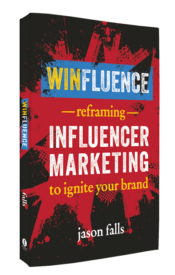Two advertising executives were walking along the beach when one tripped over a golden lamp. He picked it up, rubbed it, and a genie emerged from the spout.
“Wow!” The first said to the second. “I think this means we get three wishes.”

The genie shook his considerable finger and explained the ad man was mistaken.
“I’m not that kind of genie,” he explained. “You actually tripped over a faulty lamp. My magic power is I take away your vocabulary, sans two words. So you must now choose the two words that you can each say . You’ll never be able to utter another. I suggest you choose wisely.”
The second ad executive—probably a creative director—grabbed the first by the arm and pulled him close, whispering something in his year. The first pondered for a moment, nodded and whispered something back.
“Okay, Mr. Genie. We’re ready to choose our words.”
The genie looked surprised but said, okay. What two words would you like to have as your only vocabulary the rest of your days?
The ad men looked at each other, nodded, then responded to the genie:
“Reach and Frequency!”
Can You Blame Them?
It’s no surprise that advertising executives revert back to reach and frequency when building strategies. They happen to work. They even perform modestly well even when the advertising itself isn’t exactly stellar.
Quick! Tell me who the annoying personal injury attorney is in your town! What’s his or her nickname? See what I mean?
The more people you can place your advertising communication in front of (reach) multiplied by the number of times you can have them experience it (frequency), the better your chances of the communication working.
Why is it, then, that advertising agencies, brand managers and marketers who have long understood this reliable principle, start playing with influencer marketing and suddenly forget the horse they rode in on?
How Influencer Marketing Tends to Work
I can’t count how many influencer marketing campaigns I’ve seen or heard about. I study them, so the number is fairly high. I’ve also worked along side a number of influencer marketing agencies, software vendors and consultants in the last few years. We have conversations about what certain brands are doing, how one agency did something unique on a campaign and so on.
That’s why I can tell you with some degree of confidence that most influencer marketing campaigns are the one-and-done type. The brand or agency pays a chosen influencer a specific dollar amount for a specific number of posts. The posts go live, the influencer gets their money and it’s over. While the number has been increasing in recent years as the market matures, very few campaigns, especially those engineered by advertising agencies, go farther to build a relationship or even repeat a sponsored arrangement with the same influencer.
The managed services companies are not much help, either. They are in the business of delivering the client’s metric of the moment which is impressions. So they’ll move from influencer to influencer as well, always in search of a bigger number. Also, most managed services are set up to isolate the influencer from the brand, thus making relationship building and longer-term commitments a challenge.
How Influencer Marketing Should Work
Impressions is the metric-du-jour for brands and agencies these days, especially in the influencer marketing world. That’s most likely because the impression can be replicated in other channels and can, thus, be compared adequately for efficiency. The more impressions, the better. The lower the cost per impression, or cost per one-thousand impressions (CPM), the better as well.
Perhaps the genie should give today’s advertising agencies and big brand thinkers the two words chosen by the ad executives as their forever vocabulary. Maybe that will remind them that impressions don’t necessarily equal reach. And one-off engagements with influencers guarantees a frequency of one.
Influencer marketing investments made with reach and frequency in mind change the equation. You engage with an influencer, or set of influencers, consistently over time to ensure you are reaching as many of their audience members as possible. While you accomplish that, you are reinforcing the message because of the frequency of that message.
Remember what we said about reach and frequency? It works.
David Ogilvy himself once said, “If you’re lucky enough to write a good advertisement, repeat it until it stops selling.”
If you’re lucky enough to find a genuine influencer who can authentically engage their audience around your product, keep using them until they tap out or you run out, which ever comes first.
No one said finding the right influencer is easy. But I’m here to tell you that once you do, the rest should be.
Note: Photo by Louis Hansel @shotsoflouis on Unsplash

Order Winfluence now!
Winfluence – Reframing Influencer Marketing to Ignite Your Brand is available now wherever you get books. However, you can get a special discount by clicking the button below, buying on the Entrepreneur Press bookstore and using the discount code FALLS20. That earns you 20% off the retail price, just for being a reader here at JasonFalls.com. Get the book and learn why we’ve been backed into a corner to think influencer marketing means Instagram and YouTube and how reframing it to be “influence” marketing makes us smarter marketers.

